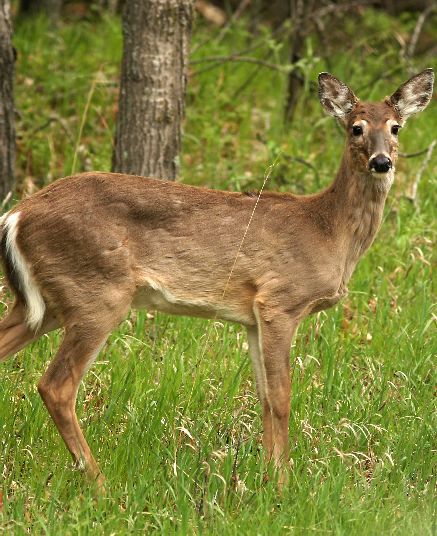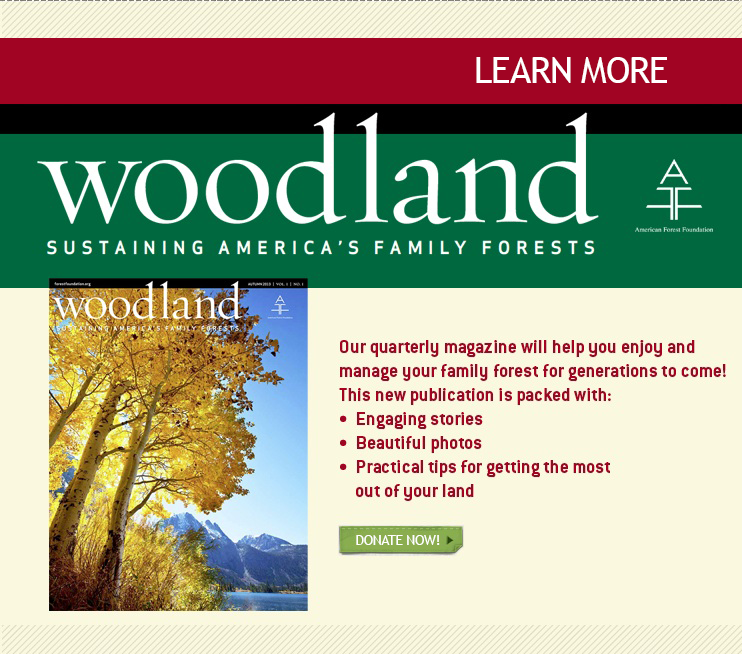Where the Wild Things Are: Enhancing Wildlife Habitat
 “My brother and I didn’t like cows, but we did like the outdoors,” says Bob Burns of the 200-acre dairy farm his family has owned since 1917 in southwestern Washington. When they inherited the property, Burns, a forester, and his brother, Roy, planted trees in pastures and managed the land for timber. Over decades, they converted the dairy farm into a Tree Farm.
“My brother and I didn’t like cows, but we did like the outdoors,” says Bob Burns of the 200-acre dairy farm his family has owned since 1917 in southwestern Washington. When they inherited the property, Burns, a forester, and his brother, Roy, planted trees in pastures and managed the land for timber. Over decades, they converted the dairy farm into a Tree Farm.
Soon black-tailed deer, the area’s native deer, became a common sight. As fields became forests, other creatures returned: bear, Roosevelt elk, hawks, owls, the occasional bobcat
and the rarer cougar. Today, the Lester Burns Family Tree Farm, the 2007 Washington Tree Farmers of the Year, is home to everything from bugs to bald eagles.
“Just about every creature found in this part of the country is found on our property,” says Burns.
Once a year the family gives tours of the Tree Farm, not so much to show off the property, says Burns, as to spread the word that being passionate about growing trees means doing what’s right for the landscape, resulting in healthy wildlife populations.
There are many reasons for enhancing the wildlife habitat on your property. “A lot of people really enjoy getting to see wildlife, or at least knowing that wildlife is still wandering through their land,” says Dana Sanchez, an extension wildlife specialist and assistant professor at Oregon State University. “Also, plenty of people value the ecosystem services provided by wildlife species.” Ecosystem services are benefits provided by healthy landscapes and the creatures that inhabit them—for example, bats and birds eat bugs that can harm trees or crops.
Many people enhance the wildlife habitat on their woodland to improve hunting opportunities. A small but growing number of landowners are finding profit in the wildlife on their land, either by leasing hunting rights or through eco-tourism.
What All Wildlife Needs
“Managing a forest for wildlife is a little bit science and a little bit art,” says John Niewoonder, a wildlife biologist for the Michigan Department of Natural Resources Wildlife Division. “You have to know what you want and what your forest is capable of providing.”
In other words, you may want Roosevelt elk, like the Burns family, but unless you live on the western coast of North America even the best wildlife habitat management is not going to bring them to your property.
“All animals require food, water and some form of cover. Some species also have specific requirements,” says Sanchez. The first step to creating a wildlife management plan is to assess what wildlife might be on your land, she says. You can do this yourself or with the help of local experts.
Your consulting forester is a good person to start with when seeking advice about enhancing the wildlife habitat. A state wildlife biologist, also known as a district wildlife biologist, or a university extension wildlife biologist are other valuable resources. The Wildlife Society provides a list of certified wildlife biologists who are available for consulting.
The U.S. Department of Agriculture’s Natural Resources Conservation Service (NRCS) offers wildlife expertise in addition to other services, and your local conservation district may be helpful as well.
A recent joint program of the American Tree Farm System® (ATFS) and the Quality Deer Management Association allows a consulting forester to be certified as an ATFS inspector and as a Quality Deer Management Association inspector.
“Inspectors can go out and certify for both programs at the same time,” says Michael J. Burns, Program Resource Manager for ATFS, making certification more convenient
for landowners, and illustrating the close relationship between healthy woodlands and healthy wildlife.
When orthodontist Skeet Burris and his wife, Gail, bought a 95-acre abandoned farm on South Carolina’s southern coast, they immediately sought out experts to help them make
their vision of productive woodlands and plentiful wildlife a reality.
Listening to those experts paid off. In 2000, the Burris family was named National Tree Farmers of the Year, and today they own 2,700 acres of woodlands that are home to wood storks and egrets, turkey and quail, rare songbirds and federally endangered woodpeckers and, of course, plenty of healthy whitetailed deer.
Deer Love Woodland Edges
Burris says that managing for deer was his family’s goal from the start. Hunting was a treasured family activity as Burris and his wife raised five boys.
White-tailed deer are creatures of edge habit, thriving where woodlands and fields meet. As he turned farm fields to forests, Burris was advised not to plant trees everywhere, but to leave some fields open and to clear some spaces in forested areas.
Woodland openings can be created by natural events such as fires or windstorms, or they can be human-made. Woodland openings can be maintained through disking, controlled burning or selective herbicide use. (Fire or chemicals may require a permit or a license in
your area, and always benefit from training and expert advice.)
The work you do for deer will also benefit a whole suite of wildlife species, including many small game species such as rabbit, turkey and quail. Burris says that without special effort the population of quail and turkey on his property has increased along with the population of deer.
Now that the boys in the Burris family are grown men, Burris leases some of his land for deer hunting. Because of the health of the deer herd on his property, he is able to get payments near the top of the regional range of $8 to $20 an acre. Through the lease, the hunters all agree to quality deer management principles, he says.
Providing Shelter and Food
While woodland openings and well-maintained edges are the most significant changes you can make to the landscape to benefit wildlife, leaving slash on the ground after logging and leaving dead trees in the woods are two other steps you can take for wild creatures.
“Some loggers chip the tops of trees and haul them out,” says Niewoonder. “Some people like that because it looks nice and neat.” But slash benefits small animals like rabbits
and songbirds, which use it for protection from the elements and from predators.
Brush piles are a compromise between leaving slash everywhere and stripping a logging site clean of debris. Brush piles should be large, and should be loosely packed so that an animal like a rabbit can move through it.
Standing dead trees, or snags, are so important to cavity nesters such as owls, woodpeckers, songbirds and squirrels that some landowners, such as Bob Burns, girdle trees and leave them standing for these creatures. Burns also likes to leave fallen trees on the ground, where squirrels, weasels and other small creatures use them.
While most people don’t think of a fish as a woodland creature, good forest management is vital to healthy fish populations. Tree cover over rivers and streams is important for fish, especially cold-water fish such as trout and salmon. Banks lined with trees or shrubs provide hiding spots for fish, and for the insects they eat. Downed trees in rivers and streams create scour pools and eddies, which are important fish habitats.
The Forest Food Chain
Providing food for wildlife can be tricky. “Trying to mimic nature is one thing,” says Sanchez, “but trying to over-supplement and bring animals together in unnatural densities is not healthy for either animals or humans.”
Native plants that provide nuts and berries are a good foundation for a forest food chain. Once you start attracting the smallest animals to your land, even insects, their predators will follow.
Providing diversity of all types: habitat types, tree species and other plant species, is fundamental to providing for wildlife—especially for their food needs—in the most natural way possible.
Govenment Help for Private Forests
At the federal level, the key agency for funding wildlife conservation on non-industrial, private forests is the NRCS.
“We’re a nonregulatory agency with a mission to provide technical assistance to private landowners,” says Mark Parson, acting team leader of the NRCS Environmental Quality
Incentives Program (EQIP). EQIP and the Conservation Stewardship Program (CSP) may cover as much as 75 percent of the cost of a wildlife habitat improvement project. In some states a forest that provides valuable wildlife habitat may be eligible for compensation through the Healthy Forest Reserve Program, says Parson.
Starting in 2012, NRCS shifted one popular wildlife habitat funding program, the Wildlife Habitat Improvement Program (WHIP), to focus on enhancing habitat for seven imperiled species. Four of the seven species need forest habitat: the gopher tortoise, which lives in the
Southeast’s longleaf pine forests; the New England cottontail; the bog turtle and the golden-winged warbler.
An Investment in the Future
Of the many reasons people have to enhance their woodlands for wildlife, perhaps none is more powerful than the way wildlife connects people to the landscape.
When Bob and Roy Burns inherited the land that would become their Tree Farm, cows wandered through the streams, causing erosion. Road culverts were too small for the stream flow, or were elevated, blocking fish from swimming upstream. Streams baked in the sun as they passed through open pastures.
The brothers fenced off the streams to keep the cows out. They planted native conifers along the stream to shade it. They widened and lowered culverts so the native cutthroat trout could swim upstream and down. Soon native plants crowded the stream banks, providing food and shelter for animals in and out of the stream.
Today the creek running through their property is home to a population of cutthroat trout that are small in size—just six to seven inches—but healthy. “It’s a small thing,” says Burns, “but it’s a big thing to kids between the ages of six and eleven.”
As he did with his own children, today Burns leads fishing expeditions for his grandchildren, who are triumphant when they catch a fish.
The Burns family treasures the legacy of this land, and wishes to keep it in the family. His children are already interested, says Burns, and plans are being made for his grandchildren as well. Burns already has them hook, line and sinker.










I like this deer